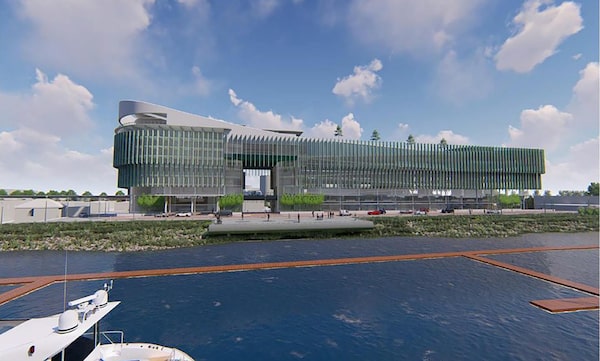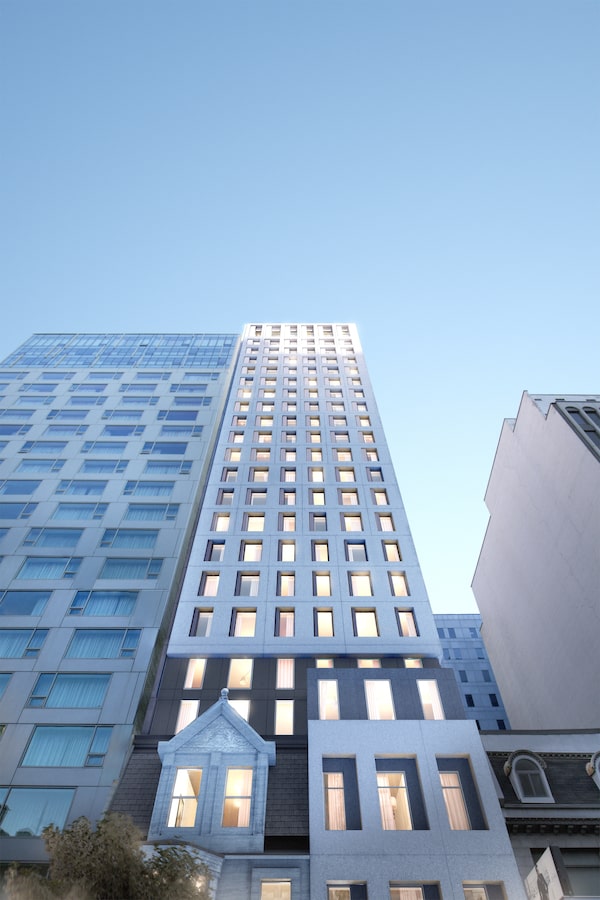
CEG Cybercity, in Richmond, will be tech-focused, with schools for animation, software design and more, offices for Vancouver’s booming tech industry, and a micro-suite hotel.
As college and university students return to campus, a Vancouver private college owner-turned-developer is about to break ground on a massive new education campus centre that will be the first of its kind in North America.
The 49-storey tower will combine residences for hundreds of students and teachers on top of five to 12 schools of various disciplines situated on the building’s lower floors. The $270-million skyscraper will also include administrative offices for the schools, a wellness centre, a food court and student support services such as travel agents, a job placement centre and international-student immigration consultants, to name a few.
GEC Education Mega Centre will rise amid the dense, Surrey City Centre Skytrain community, already home to more than a dozen postsecondary schools, including campuses for Simon Fraser University, Douglas College and Kwantlen Polytechnic University. The Mega Centre’s 383 rental units will be available to students attending any school – not just to those who will simply take an elevator from home down to class.
More than residential
Amalgamating multiple schools, student housing, offices and retail in one building “will completely differentiate GEC from any student-housing providers worldwide,” says Toby Chu, president and chief executive officer of CIBT Education Group, which owns five schools, including Sprott Shaw College’s 24 campuses, and seven student residencies under the company’s GEC brand.

The CEG Mega Education Centre in Surrey is expected to be completed by 2025.
“The student-housing business is residential only. Our Education Mega Centre is much more: It’s an integrated hub for education and affordable living,” says Mr. Chu, whose company operates language, health care and business colleges.
“I would say 99.9 per cent of off-campus student-housing operators around the world come from the real estate or finance sectors,” he adds.
Metro Vancouver counts just 13 public universities and colleges, but more than 1,500 private institutions – ”all fragmented and spread out,” Mr. Chu says. By bringing public, private, ESL and career-oriented schools together to share facilities – computer lab, library and food services – the Mega Centre allows schools to substantially reduce operating costs, Mr. Chu says.
The model’s one-stop solution for the academic community is also being developed in Richmond, B.C., where GEC Cybercity and GEC Education Super Centre are in permitting stages.
Cybercity will be tech-focused, with schools for animation, software design and more, offices for Vancouver’s booming tech industry, and a micro-suite hotel. Just blocks away, the Super Centre will feature two towers, one for schools and offices, the other for student housing.
GEC is also building an 18-storey residency-only tower at the massive Oakridge Centre redevelopment. In total, these four developments will add 2,200 beds to GEC’s current 1,500-bed portfolio, making it Canada’s leading education real estate company, Mr. Chu says.
Residences are full
While Statistics Canada has predicted a 20-per-cent drop in Canadian student registration this year because of the pandemic, a perennial demand for student housing persists: Most purpose-built student accommodation buildings in Canada remain full, according to a report by Cushman and Wakefield.
“It is estimated that only 39,000 off-campus student housing beds are available in Canada, compared to more than 400,000 students across the country who are looking for accommodations,” the report states.
David Ho, executive vice-president at global commercial real estate firm CBRE, says education has rapidly become a multibillion-dollar industry. It’s now one of Canada’s top 10 GDP sectors. Yet “student housing has not been adequately addressed. There’s potential for exponential growth,” Mr. Ho says.
The “no vacancy” notices at GEC’s student rental buildings in Metro Vancouver bode well for another sign investors will note at six of the seven buildings: “For sale.”
The recent listings, representing 413 units with a total transaction value worth $230-million, according to Mr. Chu, are part of GEC’s goal to focus on (and finance) its new large-scale concept. “We plan on expanding our education supercentres to Toronto and Montreal, and possibly to Seattle and other high-density U.S. cities,” says Mr. Chu.
Affordable, yet profitable
Operating a profitable student-housing company that also keeps rents affordable for students is mostly about floor plan optimization and smart furniture design, Mr. Chu says.
“I’ve lived in Asia for some time and do lots of business there. I’ve seen 500-square-foot units accommodating a family of four, even six. It’s incredible how they do it.”
CBIT owns GEC Smart Furniture, “which uses a lot of innovative ideas from Asia and Europe to manufacture furniture that makes small spaces comfortable. A bed turns into a desk, a coffee table lifts and expands into a six-person dining table.”
GEC residences are typically 500-square-foot, two-bedroom units, costing between $800 and $1,200 for every student. (GEC single-person units, at about 200 square feet, are larger than the 140-square-foot Nano Suites offered for $700 to students by the University of British Columbia – which saw 1,300 applicants for the 71 units when they launched in 2019.)
Meanwhile, market rent for a two-bedroom suite in Vancouver has climbed to $3,041, an increase of 1.4 per cent compared with a set record, according to Rentals.ca.
Craneless technology used to construct 19-storey student residence
In Canada, student housing embraces innovation – whether it’s a new major concept such as CIBT’s supersized academic hubs or forward-thinking architecture, such as a UBC residence, which was the world’s tallest wooden tower when it was completed in 2017.

Werkliv Group has launched construction of a new student housing development in Montreal, which will be the tallest building in Canada to be built using craneless technology.Zhiyao Chen
Now in Montreal, Werkliv Group is building a 19-storey student residence, which will be the tallest residential building in the city to be constructed of steel, a much more sustainable product than concrete, and the largest building of this type to solely feature bicycle parking.
Also of note: It will be the highest Canadian tower to be built without the use of a crane. The technology, developed by Montreal-based Upbrella Construction, sees the roof installed first and lifted, floor by floor, providing a sheltered, safer environment and speeding completions by 30 per cent.
Another sustainability feature will be the building’s heating and cooling system, which will use the domestic water supply to regulate the temperature in each apartment.
“If you’re going to take risks for the greater good, such as to benefit the environment,” Werkliv president Daniel Goodfellow says, “perhaps students are the most receptive to what you’re trying to do.”
Your time is valuable. Have the Top Business Headlines newsletter conveniently delivered to your inbox in the morning or evening. Sign up today.